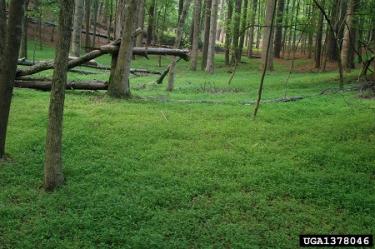When You Have a Stiltgrass Infestation
How you control stiltgrass on your land will depend on the size of your infestation. Chemical and mechanical controls are going to be your best options.
Mechanical control (pulling). Because stiltgrass is shallow-rooted, removing smaller infestations is simply a matter of pulling them up. You can remove them by hand by grabbing the base of the plant and pulling firmly. This is easiest in mid-to-late summer when the plants are taller, and when the soil is moist. Watch for seeds; if the plant is already flowering or producing seeds, make sure to bag what you pull and dispose of it offsite. You can also use mechanical means to pull stiltgrass—a lawn mower, weed whacker, or scythe will do the trick.
Herbicides. For larger stiltgrass infestations, where removing each plant may not be feasible, herbicides are a more practical option. Systemic herbicides, like glyphosate (e.g., Roundup), or herbicidal soaps (e.g., Scythe) are effective against stiltgrass. Grass-specific herbicides, such as sethoxydim, also work well on stiltgrass and can reduce potential damage to nearby woody plants.
When using chemical controls, always make sure to use the appropriate one for your setting—for example, use the wetlands formulation of glyphosate (e.g., Rodeo) for stiltgrass in wetland sites—to minimize damage to desirable plants and wildlife.
Once you’ve cleared your stiltgrass infestation—or if you’ve never had one—there are steps you can take to prevent the plant from cropping up in your woods
How can I get more tips?
It’s simple! Enter your email below.

